All OJJDP publications may be viewed and downloaded on the publications section of the OJJDP Web site. Print publications may be ordered online at the National Criminal Justice Reference Service (NCJRS) Web site.
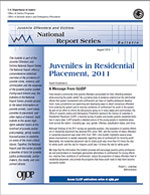
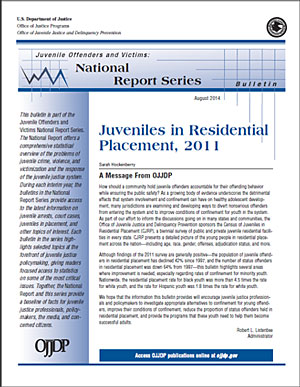 Juveniles in Residential Placement, 2011 (Bulletin)
Juveniles in Residential Placement, 2011 (Bulletin)
NCJ 246826
Juvenile Offenders and Victims National Report Series
This bulletin presents the latest available national and state-level data from the biennial Census of Juveniles in Residential Placement, which provides a detailed picture of juveniles in custody by age, race, gender, offenses, adjudication status, and more. In conducting the census for OJJDP, the U.S. Census Bureau surveys both public and private juvenile residential facilities in every state.
Although the findings of the 2011 survey are generally positive—the population of juvenile offenders in residential placement has declined 42 percent since 1997, and the number of status offenders in residential placement was down 64 percent from 1997—this bulletin highlights several areas where improvement is needed, especially regarding rates of confinement for minority youth. Nationwide, the residential placement rate for black youth was more than 4.5 times the rate for white youth, and the rate for Hispanic youth was 1.8 times the rate for white youth.
To view and download this publication, or to order a printed copy, visit the NCJRS Web site.
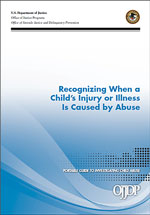
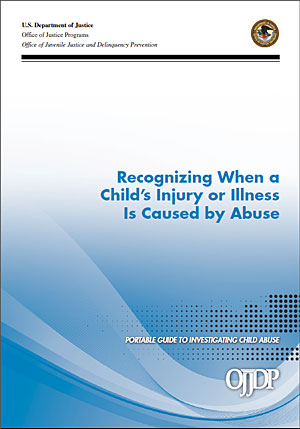 Recognizing When a Child’s Injury or Illness Is Caused by Abuse (Portable Guide)
Recognizing When a Child’s Injury or Illness Is Caused by Abuse (Portable Guide)
NCJ 243908
It is estimated that law enforcement agencies in the United States investigate more than 3.3 million cases of child maltreatment each year. This guide, first developed in 1996, provides updated information about the many indicators of child maltreatment and abuse to help first responders and investigators differentiate between physical abuse and accidental injury. Over the years, advancements in medicine have helped further distinguish between accidental and abusive injuries. This fourth edition of the guide reflects the most current literature on how to distinguish between types of injuries and includes the questions that investigating officers must ask.
To view and download this publication, or to order a printed copy, visit the NCJRS Web site.
Suicidal Thoughts and Behaviors Among Detained Youth (Bulletin)
Beyond Detention Series
NCJ 243891
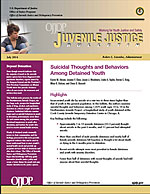
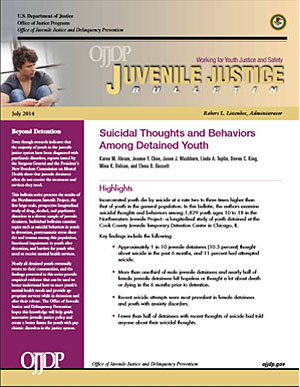
Approximately 1 in 10 juvenile detainees contemplated suicide within the 6 months prior to entering detention, according to this new bulletin, the fourth in a series on the findings of the Northwestern Juvenile Project, a longitudinal study of the mental health needs and outcomes of juvenile detainees. Researchers present data from a long-term study of the thoughts, behaviors, and psychiatric disorders of 1,829 juvenile detainees in Cook County, IL. The authors found that 11 percent had previously attempted suicide. Previous research has shown that past suicide attempts are a powerful predictor of future attempts, and detained youth are at greater risk for suicide than youth in the general population. In this bulletin, the authors conclude that juvenile detention facilities should screen for suicide risk and increase psychiatric services.
To view and download this publication, or to order a printed copy, visit the NCJRS Web site.
Online only—
Changing Lives: Prevention and Intervention To Reduce Serious Offending (Bulletin)
Justice Research Series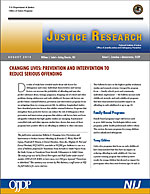
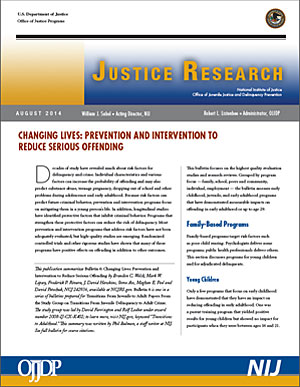 NCJ 243993
NCJ 243993
Decades of study have revealed much about risk factors for delinquency and crime. Individual characteristics and various factors can increase the probability of offending and may also predict substance abuse, teenage pregnancy, dropping out of school, and other problems during adolescence and early adulthood. Because risk factors can predict future criminal behavior, prevention and intervention programs focus on mitigating them in a young person’s life. In addition, longitudinal studies have identified protective factors that inhibit criminal behavior. Programs that strengthen these protective factors can reduce the risk of delinquency. This bulletin, published jointly by OJJDP and the National Institute of Justice, focuses on the highest quality evaluation studies and research reviews, and assesses early childhood, juvenile, and early adulthood programs that have demonstrated measurable impacts on offending in early adulthood or up to age 29.
To view and download this publication, visit the NCJRS Web site.
